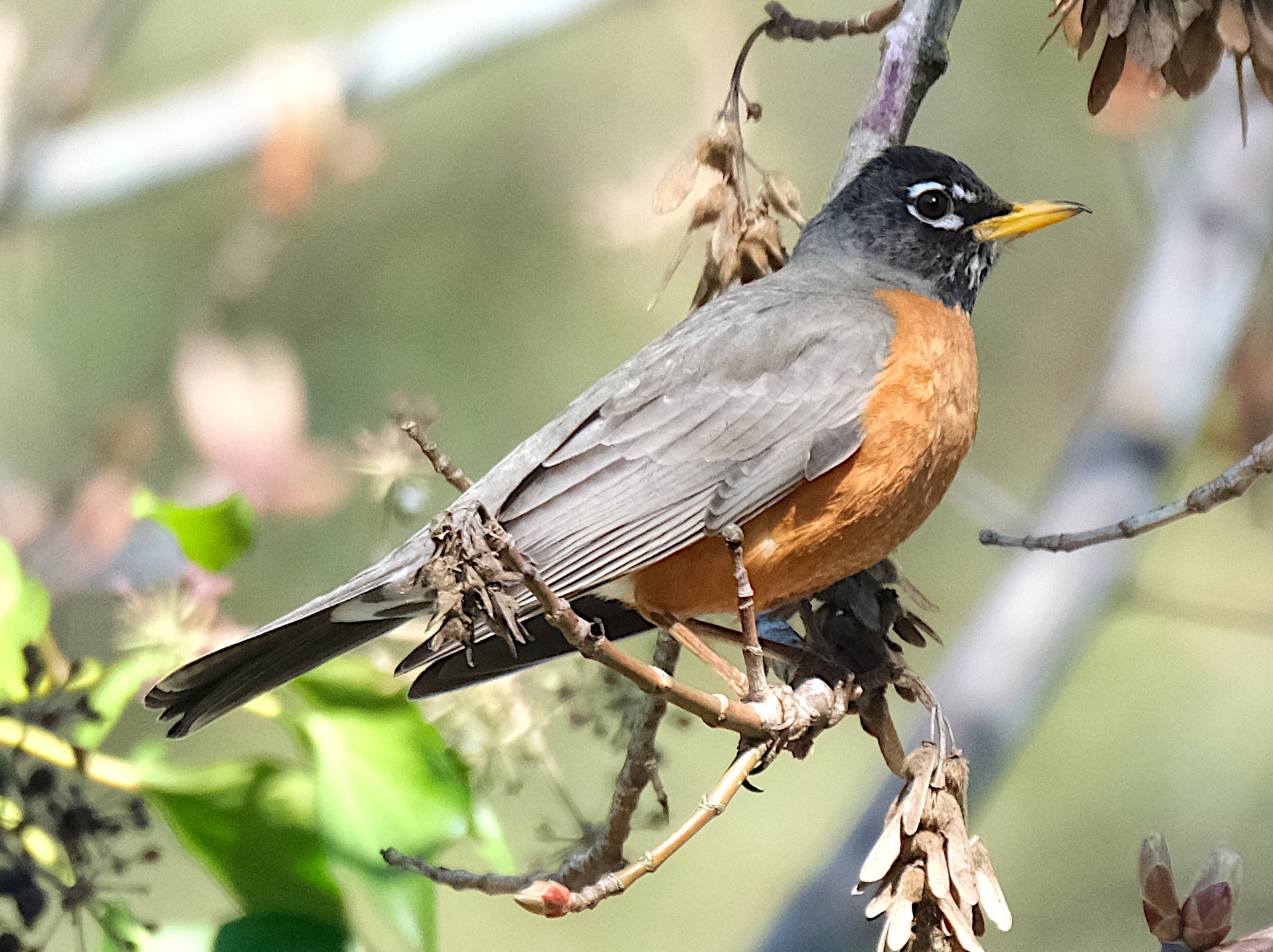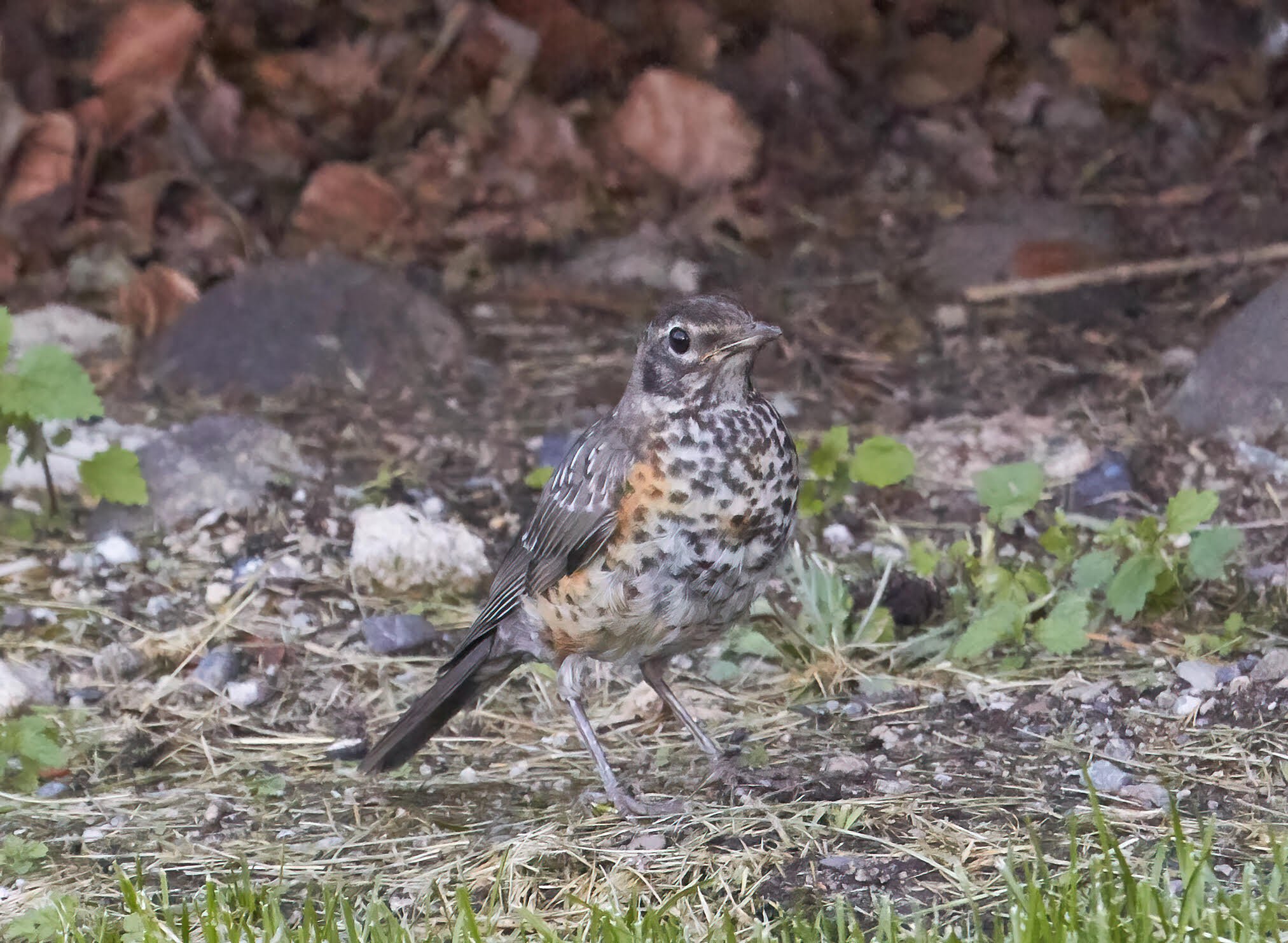American Robin
by Dave Zittin
We used to see American Robins in our backyard when we had a green lawn. Due to drought conditions, there is no lawn and there are no American Robins.
Robins are members of the thrush family. This family occurs on every continent except Antarctica. Early colonists gave the American Robin its name because it vaguely looks like the unrelated European Robin. The American Robin is the largest thrush in North America. The Western Bluebird and the Hermit Thrush are two other common thrush relatives found in Santa Clara County.
American Robin by Dave Zittin.
Robins adapt well to humans. Their range has expanded due to human activities including parkland development, domestic planting of ornamentals, orchards, and other agricultural activities which tend to promote fruit or increased invertebrate activity at or near the ground.
Ornithologists once thought that American Robins used their auditory senses to find earthworms, but recent research indicates that they use visual cues. Robins stare at the ground with one eye for long periods to find earthworms emerging from the soil. Green lawns mean wet soil and wet soil means earthworms and other invertebrates.
Green lawns also often mean pesticides. Because the American Robin associates with humans, it has become an important indicator of toxic chemicals in the environment.
American Robin by Dave Zittin.
Locally, American Robins are probably the number one carrier of West Nile disease. News accounts give the impression that crows and jays are significant carriers, but research indicates that West Nile is more common in the American Robin. And while West Nile is almost always lethal to crows and jays, robins are able to carry the disease with fewer ill effects. A mosquito species spreads the disease to birds and humans. This mosquito takes blood meals from roosting American Robins and robins then serve as an amplification mechanism enabling more mosquitos to acquire the virus and eventually infect people. It’s not the robin’s fault: it’s the virus-mosquito combination that is the culprit.
American Robins have a high mortality rate; only 25% of fledged American Robins make it through November of the year they were hatched. Even though there are records of Robins older than 12 years, research shows that nearly 100% of a year cohort dies in 6 years.
Attracting American Robins to Backyards
Fruiting plants provide an important early source of nutrition for immature robins, which are less experienced at foraging for invertebrates.
Cornell claims that American Robins are attracted to feeders, but I have yet to see one on either our suet feeder or grain feeder.
American Robin by Tom Grey.
Description
American Robins are easy to identify. The male has a black head, a yellow bill, a striped throat, a broken white eye ring, and a distinct rufous colored breast. The female looks similar but tends to have duller colors. Immature male American Robins resemble females. Juveniles are heavily spotted to a point of having a mottled appearance and are often confusing to beginning birders.
Juvenile American Robin by Brooke Miller. Note the mottled appearance.
Distribution
With a few exceptions, American Robins occur everywhere in the U.S. and northern Mexico. They are in Santa Clara County all year. Based on eBird frequency charts, they are least abundant in the county in the summer and fall.
Migration is complicated. Some individuals don’t wander far from their breeding territories. This is especially the case where climates are mild and food is available in the winter. Important factors that influence migration are the availability of ground invertebrates in the spring and edible fruit in the fall and winter. That said, many do migrate from Mexico and the southern United States to the Canadian-U.S. border and north to the Arctic Ocean during summer breeding season.
During fall and winter, robins typically roost in large flocks and spend more time in trees where edible fruit occurs. A few years ago we were birding in Florida in the winter when we came across a large leafless tree in which there were more than 200 American Robins. To date, I have not seen anything like this in Santa Clara County.
Similar Species
Nothing in Santa Clara County looks like an American Robin. The Spotted Towhee has similar rufous coloration on its flanks, but its breast is white, not rufous, and this towhee lacks a white eye ring.
The American Robin’s song contains sounds that swing upward, often sounding like “cheer-up”. They have different calls, but a common one sounds like a high-pitched whinny. The Black-headed Grosbeak’s song is similar but has segments that go down sounding like a child’s sliding whistle, and usually contains distinct short-bursts of trills that the robin lacks.
Explore
The song of the Black-headed Grosbeak - note pitch slides and trills
More Backyard Bird Information
View more common Santa Clara County Backyard Birds
Visit our Backyard Birding page
Tell us what you’re seeing in your yard! Send your notes, photos, and sound clips to backyardbirds@scvas.org. We’ll feature your submittals on our website.
Banner Photo: American Robin by Hita Bambhania-Modha





